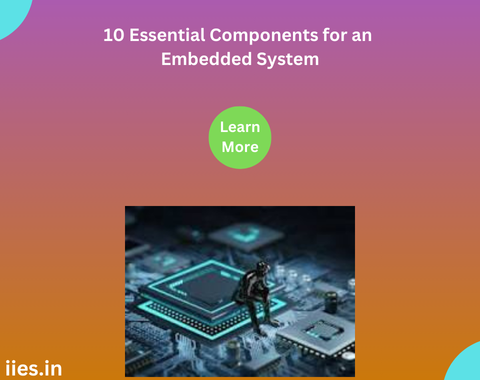
At the heart of every embedded system lies the microcontroller or microprocessor, which serves as the central processing unit (CPU). This component executes program instructions and manages the system’s operations. Microcontrollers are typically chosen for their integrated peripherals and low-power consumption, making them ideal for embedded applications where space and energy efficiency are crucial.
1.Memory
Memory is essential in an embedded system to store program code, data, and system configurations. It includes both volatile memory (RAM) for temporary data storage and non-volatile memory (ROM, Flash) for storing persistent data and program code. The size and type of memory used depend on the complexity of the application and the performance requirements of the system.
2. Power Supply
A reliable power supply is critical for the proper functioning of an embedded system. It provides the necessary electrical power to all components, ensuring stable operation. Power supplies in embedded systems may include batteries, DC power adapters, or power management circuits designed to meet specific voltage and current requirements.
3. Input Devices
Input devices allow the embedded system to interact with its environment by receiving data. These devices can include sensors (temperature, pressure, motion) and various interfaces (buttons, switches, keypads) that capture external stimuli and convert them into digital signals processed by the microcontroller.
4. Output Devices
Output devices enable the embedded system to communicate with the external world or display information to users. Common output devices include LEDs, LCD displays, actuators (motors, solenoids), and communication interfaces (Ethernet, Wi-Fi, Bluetooth). These components translate processed data or commands into tangible actions or information.
5. Real-time Clock (RTC)
A real-time clock (RTC) provides accurate timekeeping functionality, crucial for applications requiring scheduling, timestamping, or logging events. The RTC ensures that the embedded system can perform time-sensitive operations reliably and maintain synchronization with external time references.
6. Communication Interfaces
Embedded systems often require communication interfaces to exchange data with other systems or networks. Stm32 Serial communication protocols (UART, SPI, I2C) and network interfaces (Ethernet, Wi-Fi, Bluetooth) enable seamless connectivity and data transfer, essential for IoT applications and remote monitoring.
7. Operating System/RTOS
Depending on the complexity of the embedded system, it may run on a dedicated Real-Time Operating System (RTOS) or a lightweight embedded OS. These operating systems manage system resources, scheduling tasks, and ensuring efficient operation while meeting real-time constraints and power efficiency requirements.
8. Watchdog Timer
A watchdog timer is a hardware component that monitors the operation of the embedded system. It resets the system in case of a software hang-up or malfunction, ensuring system reliability and preventing potential failures that could otherwise go unnoticed.
9. Enclosure/Package
The enclosure or package provides physical protection and environmental isolation for the embedded system components. It shields sensitive electronics from mechanical damage, moisture, dust, and other environmental factors, ensuring long-term durability and reliability in various operating conditions.
In conclusion, these essential components collectively enable embedded systems to perform dedicated functions reliably and efficiently across a wide range of applications, from consumer electronics and industrial automation to automotive systems and IoT devices. Each component plays a critical role in ensuring the system’s functionality, performance, and resilience in diverse operating environments.
Indian Institute of Embedded Systems – IIES